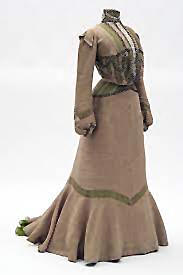| |
| |
|
|
|
| |
| |
NOT JUST SLAVE CLOTH --
"TO 4 YARDS OF OZENBRIGS"
Ozenbrig was a fabric often cited in runaway
notices; an example:
| |
Henry Goatly,
aged about Eighteen Years, large of his age,
pretty long light-coloured Hair, full-faced
and very talkative, with a pretty good Felt
Hat, Cotton Jacket and Breeches, Ozenbrig
Shirt, Grey Yarn Stockings, and a Pair of
plain Shooes: a Scotch-Irish,
thieving, lying, sawcy Fellow. |
As the least expensive fabric available (other than
shalloon which was typically only used for linings),
ozenbrig certainly had its place in colonial
society. A tough coarse linen made of hemp or
flax, similar in texture to burlap, and sold in
natural, white, brown and blue solid colors (or in
stripe or check combinations of those same shades),
ozenbrig rapidly developed a singular reputation (as
many masters in the 18th century required their
slaves to wear ozenbrig).
Those who wore this fabric were thereby easily
identified as laborers, or as indentured bondsmen,
or as enslaved. Thus, as time progressed, few
individuals would willingly choose to wear the
fabric. But such was not always the case.
The early days of the Pennsylvania frontier
(1744-1746 -- the frugality years) saw
ozenbrig being sold not as a fabric specific
to slave attire, but rather as the fabric of
choice to be worn by the common man.
Ozenbrig would be fabricated into nearly
everything from breeches, trousers, vests,
jackets, shirts and suits, to stockings,
aprons, petticoats and shifts, to sheets,
table covers, carpetbags and wallets.
The Dupui ledger shows the sale of ozenbrig
to eight area families (none of whom were
known to own slaves). Interestingly enough,
the known slave-owning families in the
region conversely have no ledger entries at
all that would indicate the purchase of
ozenbrig at Dupui's store.
It wasn't long, however, before the
relatively coarse ozenbrig would lose its
appeal. For an additional 6 pence, one
could buy linen; or for an additional
shilling, check linen could be bought. In
fact, we wind up seeing close to six dozen
linen transactions in the Dupui ledger just
within the next dozen years. |
|
 |
The comfort of linen clearly triumphed over the
inexpensiveness of ozenbrigs. The consumer had
spoken.
|
|
| |
|
| |
|
|
|
| |
|
|
|
| |
|
|
|
| |
|
|
| |
|
|
|
|